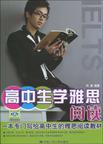高中生学雅思阅读
出版时间:2010-1 出版社:中国人民大学出版社 作者:何满 页数:295
Tag标签:无
前言
这是一本专门写给高中生的雅思阅读教材。 在保持与雅思考试密切相关的前提下,本书尽可能地选取高中生感兴趣的话题。例如在主题为环境的章节中,本书选取的文章为《宝马的无污染引擎》,在这篇文章中考生既可以学到与汽车污染相关的单词,又不会觉得文章枯燥无味。在主题为高科技的章节中,本书选取的文章为《学校使用iPPhones防止学生逃学》,又一个高中生热衷的话题。 本书所有文章主体选自西方报纸杂志,如《经济学人》、《国家地理》、《新科学家》等。每单元所选课文分为三个级别,课文长度分别为300~400字、600~700字、1000~1200字,单词难度分别为4000词、5500词、7000~8000词。由简入难,循序渐进,使考生实现从高中英语到雅思考试的过渡。 全书分为课本(TEXT)和测试题(TEST)两部分,共计20个单元,涵盖了自然、社会、环境、健康等十大题材。考生通过对本书的学习,可以掌握雅思阅读考试相关的文章内容,积累大量的常见题材的相关词汇。课文(TEXT) 本部分包含10个单元,每个单元的结构如下: 1.核心单词。对于课文中的难词和核心词汇,书中配有精确的中英文解释,并对部分单词进行同义词扩充。单词的英文解释参照剑桥英语词典和朗文当代英语词典。 2.关键句型。本部分收录课文中的关键句型以及较难的语法结构。长句和难句在雅思阅读文章中频繁出现。考生通过对课文中复杂语法结构的学习,可以迅速扫除雅思阅读考试中的难句障碍,同时提升自身的写作能力。 3.题型练习。本部分精心设置了各种题型的练习题,帮助考生真正理解课文的内容,掌握雅思阅读考试相关题型的解题技巧,深入领会雅思阅读考试的命题思路,最终获得海外学习所需的阅读技能。
内容概要
本书所有文章主体选自西方报纸杂志,如《经济学人》、《国家地理》、《新科学家》等。每单元所选课文分为三个级别,课文长度分别为300~400字、600~700字、1000~1200字,单词难度分别为4000词、5500词、7000~8000词。由简入难,循序渐进,使考生实现从高中英语到雅思考试的过渡。 全书分为课本(TEXT)和测试题(TEST)两部分,共计20个单元,涵盖了自然、社会、环境、健康等十大题材。考生通过对《高中生学雅思阅读》的学习,可以掌握雅思阅读考试相关的文章内容,积累大量的常见题材的相关词汇。
作者简介
何满,世纪雅思(北京)副校长,著名雅思和托福考试培训教师,雅思培训界新生派的代表人物。对雅思考试的题型解题技巧及发展趋势把握精准,授课风格生动幽默,用最简洁的语言诠释雅思考试。独创的“扫描跳读法”以及“象形记忆法”帮助众多中国考生攻克阅读难题,并一次性彻底摆脱背诵英语单词的苦恼。
书籍目录
Part One TEXT UNIT 1EDUCATION Step 1 Grouping Students Step 2 Australian Education System Step 3 The New SAT UNIT 2 ARCHITECTURE Step 1 Thatching in England Step 2 Sydney Opera House Step 3 Isambard Kingdom Brunel UNIT 3 CULTURE Step 1 Tourists in America Step 2 Politeness in Different Cultures Step 3 A Brief History of Ancient Coins UNIT 4 NATURE Step 1 Sustainable Development of Agriculture Step 2 Tropical Rainforests Step 3 Otter UNIT 5 TECHNOLOGY Step 1 iPhones in Universities Step 2 DNA Forensic Science Step 3 Facial Recognition UNIT 6 ENVIRONMENT Step 1 The Power of Pesticides Step 2 Top 7 Renewable Energy Sources Step 3 BMW Greenwashing? Do They Really Make a Pollution Consuming Engine? UNIT 7 TRANSPORTATION Step 1 American Transportation Step 2 The History of Transportation Step 3 Transport in South Africa UNIT 8 SPORTS Step 1 The Importance of Exercise Step 2 Vanuatu's Nabanga Sport Gains Momentum Step 3 The Impact of Professional Athletes on the Olympic Games UNIT 9 HEALTH Step 1 Acupuncture Step 2 Childhood Obesity Step 3 Health Care for America UNIT 10 BUSINESS Step 1 Resume Step 2 How to Flee an Ailing Industry Step 3 Peter Ferdinand DruckerPart Two TEST UNIT 1 EDUCATION Step 1 The Importance of Educating Women Step 2 Teaching Assistants Don't Boost Pupils' Progress Step 3 International Students May Spurn UK Because of New Visa Rules UNIT 2 ARCHITECTURE Step 1 Buckingham Palace Step 2 Aswan Dam Step 3 France Castles UNIT 3 CULTURE Step 1 Cultural Blindness and Linguistic Ignorance Step 2 Tea in America Step 3 The History of Papermaking in the UK UNIT 4 NATURE Step 1 Oil in ANWR Step 2 What Are Dolphins? Step 3 How to Slake a Planet's Thirst UNIT 5 TECHNOLOGY Step 1 Robot Step 2 TV Addiction Step 3 Magnetic Therapy: Plausible Attraction? UNIT 6 ENVIRONMENT Step 1 Global Warming Step 2 Greenhouse Gases Step 3 How Does Recycling Work and Should We Really Bother? UNIT 7 TRANSPORTATION Step 1 Transport in London Step 2 Traffic Congestion Dips As Economy Plunges Step 3 Public Transportation UNIT 8 SPORTS Step 1 Children with a Disability Get a Kick out of Capital Football Step 2 Strengthening National Talent Identification Step 3 Australian Success, but Sport at Critical Point UNIT 9 HEALTH Step 1 The Change of Human Height Step 2 Aromatherapy Step 3 American Obesity UNIT 10 BUSINESS Step 1 The Role of Market Investigations Step 2 Manage Your Sales Force More Effectively Step 3 Motivating Employees Without MoneyAnswers to TEXT QuestionsAnswers to TEST QuestionsGlossary of TEST
章节摘录
The new SAT scores are out, and buried in them is a sign of hope for American education. True, the scores are actually a bit lower than last years; the combined average for the SATs math and reading sections fell 7 points, to 1021, the biggest decrease since 1975, when the score dropped 16 points, to 1010. But statistically speaking, a 7-point decline (out of a possible 1600 on those two sections) isnt much. Its less than the value of a single question, which is about 10 points. Also, the SAT was radically changed last year. The College Board made it longer and added Algebra 11, more grammar and an essay. Fewer kids wanted to take the new 3-hr. 45-min. test more than once, so fewer had an opportunity to improve their performance. Scores were bound to slide. But tucked into the reams of data the College Board included with the new scores was some wonderful news. I was wrong. In 2003 I spent six months tracking the development of the new SAT. I sat through hours of test-development sessions and even learned how to grade SAT essays. TIME ran my resulting story on its cover that October. The story did make some predictions that turned out to be right. For instance, the new test favors girls more than the old one did. It is a long-standing tenet of test-making that girls outperform boys on writing exams. For reasons I am not foolish enough to speculate about in print, girls are better than boys at fixing grammar and constructing essays, so the addition of a third SAT section, on writing, was almost certain to shrink the male-female score gap. It did. Girls trounced boys on the new writing section, 502 to 491.
编辑推荐
一本专门写给高中生的雅思阅读教材 文章分级,由浅入深,循序渐进,实现从高中生英语到雅思考试的过渡,真正提升英语能力 收录大量针对性专项练习,基础与技巧并重,使高中生也能拿高分
图书封面
图书标签Tags
无
评论、评分、阅读与下载
用户评论 (总计18条)
- 对刚刚开始学习雅思的同学来说很有帮助哦
- 已经仔细看了,该书涵盖的知识比较全面,有助于备考雅思,大学生看看也是不错的。
- 适合高中生阅读,大学生也可以看看
- 只看了一些部分,对于高中生来说,这本书适合长久训练,一些分析什么的挺有帮助的,技巧性的东西不是很多
- 每个话题都是从易到难,后边有重点词的注释,而且每个话题后面还有两篇拓展阅读。很好。帮助很大~
- 适合高阶段英语阅读
- 很棒 对英语学习非常有帮助
- 下午刚刚拿到包裹,拆开来看看,很不错的书
- 刚收入到(给孩子买的),还没读呢,但感觉书不错,正版的,快递速度挺快,态度非常好,很满意。
- 质量不错,总体感觉偏好
- 蛮好的书哦
- 现在适合高中生的雅思书很少,不管这个书到底怎么样,起码是一种很好的开头,今天在新华书店又看到相关系列的书了,现在我需要多花点时间好好研究下,看怎么利用好他们帮助高中生提高雅思成绩。
- 给小孩子买的,对于没接触过雅思的她来说,比较难
- 文章长度循序渐进,不会让高中生感到恐惧
- 作为高中生起点的考生难度挺适合的,模拟题就一般。
- 不过为什么文章没有译文
- 还不错。应该会有帮助的。
- 还没看过,不过翻了翻,感觉不错
